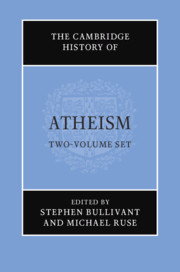Book contents
- The Cambridge History of Atheism
- The Cambridge History of Atheism
- Copyright page
- Dedication
- Contents
- Acknowledgments
- Contributors
- Introduction
- Part I Preliminaries
- Part II Atheisms in History
- Part III Reformation, Renaissance, Enlightenment
- Part IV Classical Modernity: Philosophical and Scientific Currents
- Part V Classical Modernity: Social and Political Currents
- Part VI Twentieth and Twenty-First Centuries: Intellectual and Artistic Currents
- Part VII Lived Atheism in the Twentieth- and Twenty-First Centuries: Case-Studies
- 42 Latin America
- 43 The Road to Modern China
- 44 Contemporary China
- 45 Atheism in India: Twentieth Century and Beyond
- 46 The Soviet Union
- 47 Modern Germany
- 48 The Nordic and Baltic Countries
- 49 United States
- 50 The Pacific Northwest
- 51 Tunisia
- 52 Southern Africa
- 53 Traditional Societies
- Part VIII Emerging Atheisms in the Twenty-First Century
- Part IX Conclusion
- Index
- References
53 - Traditional Societies
from Part VII - Lived Atheism in the Twentieth- and Twenty-First Centuries: Case-Studies
Published online by Cambridge University Press: 25 September 2021
- The Cambridge History of Atheism
- The Cambridge History of Atheism
- Copyright page
- Dedication
- Contents
- Acknowledgments
- Contributors
- Introduction
- Part I Preliminaries
- Part II Atheisms in History
- Part III Reformation, Renaissance, Enlightenment
- Part IV Classical Modernity: Philosophical and Scientific Currents
- Part V Classical Modernity: Social and Political Currents
- Part VI Twentieth and Twenty-First Centuries: Intellectual and Artistic Currents
- Part VII Lived Atheism in the Twentieth- and Twenty-First Centuries: Case-Studies
- 42 Latin America
- 43 The Road to Modern China
- 44 Contemporary China
- 45 Atheism in India: Twentieth Century and Beyond
- 46 The Soviet Union
- 47 Modern Germany
- 48 The Nordic and Baltic Countries
- 49 United States
- 50 The Pacific Northwest
- 51 Tunisia
- 52 Southern Africa
- 53 Traditional Societies
- Part VIII Emerging Atheisms in the Twenty-First Century
- Part IX Conclusion
- Index
- References
Summary
Anthropologist Jack Goody (1996, 679) noted that ‘Both gods and doubts are widespread, transversal (if not universal) aspects of culture, the result not of inbuilt processes but of the interaction between language-using human beings and their social and natural environment.’ There are two important points Goody conveys here. First, doubt – that is, reluctance or resistance to adopt received wisdom (see Box 53.1) – exists in all societies. Second, doubt does not exclusively spring from some internal faculty, but rather is the output of a complex set of inputs to an organism that produces, manipulates, and transmits ideas. In other words, doubt emerges as the product of a systemic process. One implication of this view is that doubt can express itself differently across contexts; if humans’ social and natural environments vary, it follows that doubt – as rising from their interaction – should exhibit itself in a corresponding fashion.
- Type
- Chapter
- Information
- The Cambridge History of Atheism , pp. 982 - 1004Publisher: Cambridge University PressPrint publication year: 2021
References
- 3
- Cited by



